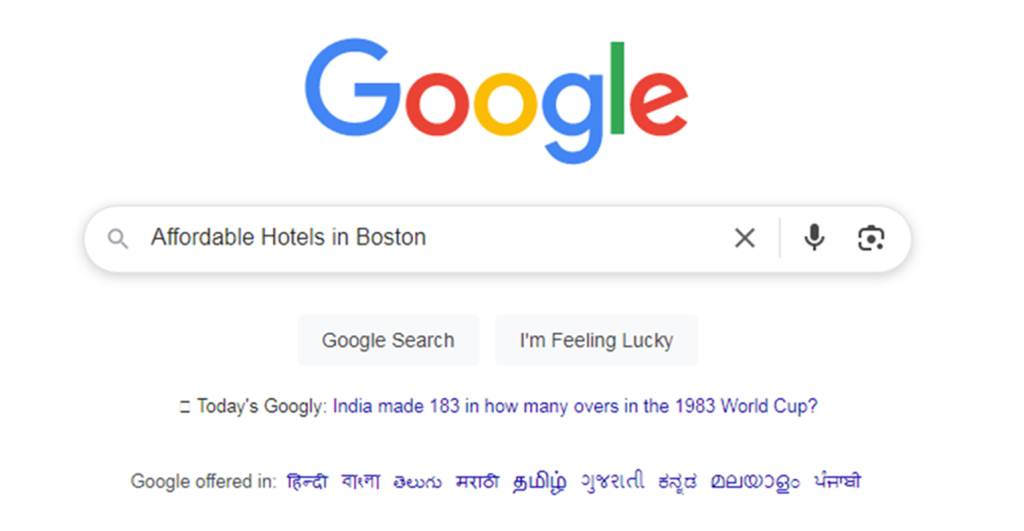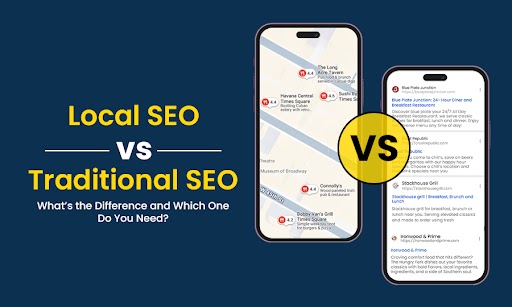A large number of people of late rely on online mediums to find products, businesses, services, etc. They put their query on Google and other search engines to get the search outcomes. It increases the importance of SEO. Meanwhile, traditional and local SEO are two important types of SEO. We will discuss local SEO vs traditional SEO to discuss major differences between these two.
As per stats, websites that appear on top in search results claim approximately 27.6% of overall clicks. It increases the importance of search engine optimization (SEO). Search engine optimization gives you a kind of surety that you will reach the top position of the search outcomes. If not, you can leverage various SEO checker tools to find out what prevents your website from being top spot.
Meanwhile, some businesses operate locally and thus target their nearby customers. If you are one of those operating any physical store, you need to opt for local SEO strategies. Of course, there’s a huge difference between local SEO and traditional SEO. We will also discuss how local SEO is different from organic or traditional search engine optimization.
What is Traditional SEO?
Traditional SEO is a technique to improve search engine ranking and the position of a website in Search Engine Result Pages (SERPs). It’s useful for businesses in any industry. Search engine optimization is a combination of many on-page and off-page strategies to improve your website’s ranking in search results.
How Does Traditional SEO Work?
You need to be familiar with the anatomy of a search result to understand how search engine optimization works. Let’s take an example of the keyword ‘Best Electrician in New York’. We will put this keyword in Google to see the result.

After inserting the above keyword, the result appears as follows;

This is the sponsored part that appears at the top of the search results. The company that appears in this position has to run a paid campaign.

The above is the second part of the search result, which displays mainly questions and answers platforms. It displays questions and answers related to your relevant keywords.

The above is the main and the organic search results based on your provided keywords. It shows the position of each website based on their search outcomes.
What is Local SEO?
When it comes to local SEO, it’s a part of traditional SEO. It focuses exclusively on your optimizing efforts to maximize your reach among local searchers. For instance, you plan a trip and search for ‘Affordable Hotels in Boston’. If you are an owner of any hotel in this location, you desire to appear on the local results for that search. And you can appear in that position with the help of local SEO strategies.

After inserting the keyword, the following result appears.
As per the stats, approximately 80% of local searches convert successfully. It’s indeed highly crucial to invest in local search engine optimization, especially when you have a local business seeking to increase local traffic, engagement, sales, and profit.
Apart from organic listings, SERP features, ads, and more. These local search results include certain unique features. Let’s have a look at another great example to understand the major differences between local and traditional SEO.
Brief Discussion of Local SEO vs Traditional SEO
Let’s have a brief discussion of local SEO vs traditional SEO to help you understand the key differences between them;
| Points of Differences | Local SEO | Traditional SEO |
| Search Intent | It includes location-based or near-me searches. | Traditional SEO includes transactional, informational, and navigational searches. |
| Target Audience | It emphasizes local customers within a particular location. | It targets an audience on a global or broader audience. |
| Keywords | Local SEO involves using mainly location-specific terms. | Traditional SEO involves using keywords in broader terms. |
| Backlinks | It involves creating local backlinks from local blogs or newspapers. | It includes the creation of high-authority backlinks from any niche-relevant sources. |
| Citations and Listings | It depends mainly on consistent NAP (Name, Address, Phone) across multiple directories. | It focuses less on business listings. |
| Google My Business (GMB) | It’s necessary for visibility in local map results. | It’s not generally relevant or used. |
| Content Focus | Local SEO efforts focus mainly on events, local news, community engagement, and more. | It focuses mainly on industry-specific or general topics. |
| Conversions | Local SEO is useful in conversion calls, physical visits, and local service engagement. | It’s helpful in online conversion, increasing organic traffic, or maximizing global reach. |
| SEO Tools and Metrics | Local SEO includes tools such as BrightLocal, GMB Insights, etc. | It involves using many tools such as Ahrefs, Google Analytics, SEMrush, and others. |
Major Differences between Local SEO and Traditional SEO
Now, we discuss the major differences between local SEO and traditional SEO in-depth from several points of view. Let’s discuss each point in depth;
- Search Engine Result Pages (SERPs)
Local SEO
Local SEO serves its core purpose to help businesses be visible in the local pack. Its final result appears just above the organic search results. It includes important information from Google Business Profile (GBP), including phone number, address, reviews, and hours.
Traditional SEO
Traditional SEO mainly focuses on improving the ranking of your business website in organic results. It’s listed as the local pack. The result also displays the meta description, and titles to lure visitors to click the URL of the website.
- Target Audience
Local SEO
Local SEO is useful in getting the attention of customers from specific geographical locations. It’s necessary for businesses that offer their services in particular locations or also with physical locations. Its major aim is to be visible in local search results with keywords such as ‘electrician near me’ or ‘best Indian Restaurant in New York’.
Traditional SEO
Traditional SEO focuses on maximizing your business reach among a broader audience, irrespective of location. It’s a perfect option for those businesses that function online and have a global or national customer base.
Its major goal is to rank high in organic search results for those keywords that don’t have geo-modifiers or relevant non-local keywords. Here, geo-modifiers include the names of cities, regions, neighborhoods, or towns.
- Best Practices
Local SEO
Local SEO includes the following important practices;
- Claiming your GBP
- Optimizing your GBP
- Creating local content while ensuring it’s relevant to the community
- Inserting consistent addresses, names, and phone numbers across multiple directories
- Getting local citations and backlinks
- Encouraging positive customer reviews
Traditional SEO
Traditional SEO includes the following important practices;
- Site architecture and user experience
- Keyword-optimized and top-quality content
- Domain authority and link-building
- Site speed and mobile responsiveness
- Schema markup for rich results.
- Citations and Backlinks
Local SEO
Local SEO mainly focuses on backlink building from directories, local websites, and organizations. In this, citation of many review sites and local directories is also highly important for the success of local SEO.
Citations indeed play a vital role in improving the credibility of your website. Apart from this, local backlinks are also highly important with a consistent citation across reliable directories that improve local rankings.
Traditional SEO
On the other hand, traditional SEO involves getting backlinks from authoritative websites within the industry irrespective of their geographic location. In this, acquiring backlinks from many high-authority websites works as a primary ranking factor. These include getting links from outlets, news, influential blogs, educational institutions, and more.
- Keyword Intent
Local SEO
Local SEO is the process of inserting various location-specific keywords into your posts, services, and GBP business descriptions. It also involves writing website content by keeping in mind the local audience. Local SEO focuses mainly on navigation and transactional intent within any geographic scope.
Traditional SEO
When it comes to traditional SEO, it depends mainly on leveraging broader keywords that lure a wide audience. Its content strategies mainly include creating informational and top-quality content that answers many FAQs. It also provides great solutions to many common issues as well. Its main aim is to educate the target audience and thus create an authority in the industry.
- Conversion Types
Local SEO
Local SEO conversions mainly focus on several things;
- In-store visits
- Phone calls
- Clicks to call from mobile devices
- Direction requests through Google Maps
These ‘micro-conversions’ can be tracked directly with the help of many tools including call-tracking software and GBP Insights.
Traditional SEO
Traditional SEO conversions include the following important things;
- Newsletter sign-ups
- Online purchases
- Form submissions
- Downloads
- Online Reviews and Ratings
Local SEO
In local SEO, reviews on many platforms such as Yelp, Google, Facebook, and others influence directly on both user trust and ranking. Businesses that have various positive reviews and high star ratings have the potential to appear in the Map pack and thus get more clicks.
Traditional SEO
Traditional SEO doesn’t factor mainly in customer reviews in the same way. Meanwhile, reviews contribute to the overall reliability of a brand. Meanwhile, it doesn’t directly affect any organic search rankings.
- Google Business Profile
Local SEO
As mentioned earlier, creating and optimizing GBP is highly important for local SEO success. Google Business Profile serves mainly as a comprehensive listing that includes necessary reviews, business information, photos, and links.
A perfectly-optimized profile boosts visibility in Google Search and Google Maps results. It includes social proof, especially reviews that can indeed make a great difference when it comes to brand ranking in the local pack.
Traditional SEO
GBP optimization is not necessary in traditional SEO. It can get a direct advantage of regular SEO by increasing website traffic and brand visibility. The main factors include backlinks, website content quality, and technical SEO. These factors are pivotal in ensuring organic search success.
So, which is Better – Local SEO vs traditional SEO?
Making a selection between traditional SEO and local SEO relies mainly on your core business objectives. Local SEO is the right choice for businesses seeking to target certain specific geographic areas like salons, restaurants, local service providers, and more. It helps optimize your presence for ‘near me’ searches and also many local map results, which helps mainly nearby customers find quite conveniently.
On the other hand, traditional SEO is the right option for businesses looking for a national or international audience for their services. It focuses on several things like backlinks, website content, keyword strategies, and more. These are essential to maximize visibility on a global scale.
If you depend mainly on regional clientele or foot traffic, local SEO can indeed be the best option for you. Meanwhile, if you target a wide market even beyond geographic boundaries, traditional SEO provides a better reach. When you combine both strategies, it helps you increase your online visibility and thus boost optimal results.
Conclusion
Whether it’s local SEO or regular SEO, both of them benefit businesses that operate from multiple locations. However, the core focus should be aligned perfectly with the specific needs and goals of the business.
So, once you get a complete understanding of the major differences between organic SEO and local SEO and strategically focusing efforts, brands, and multi-location. These can get most of their resources mainly when it comes to improving their online visibility. It lures the right audience thus increasing their business.

